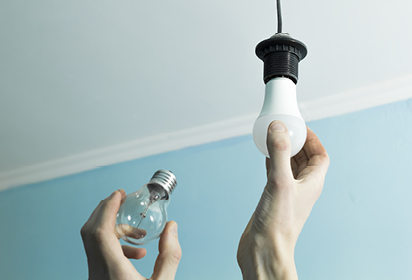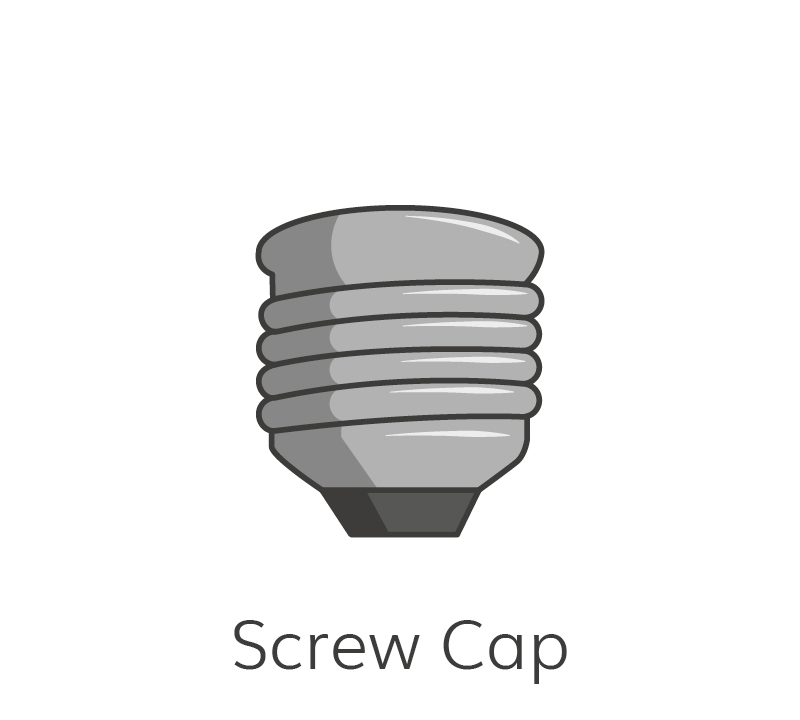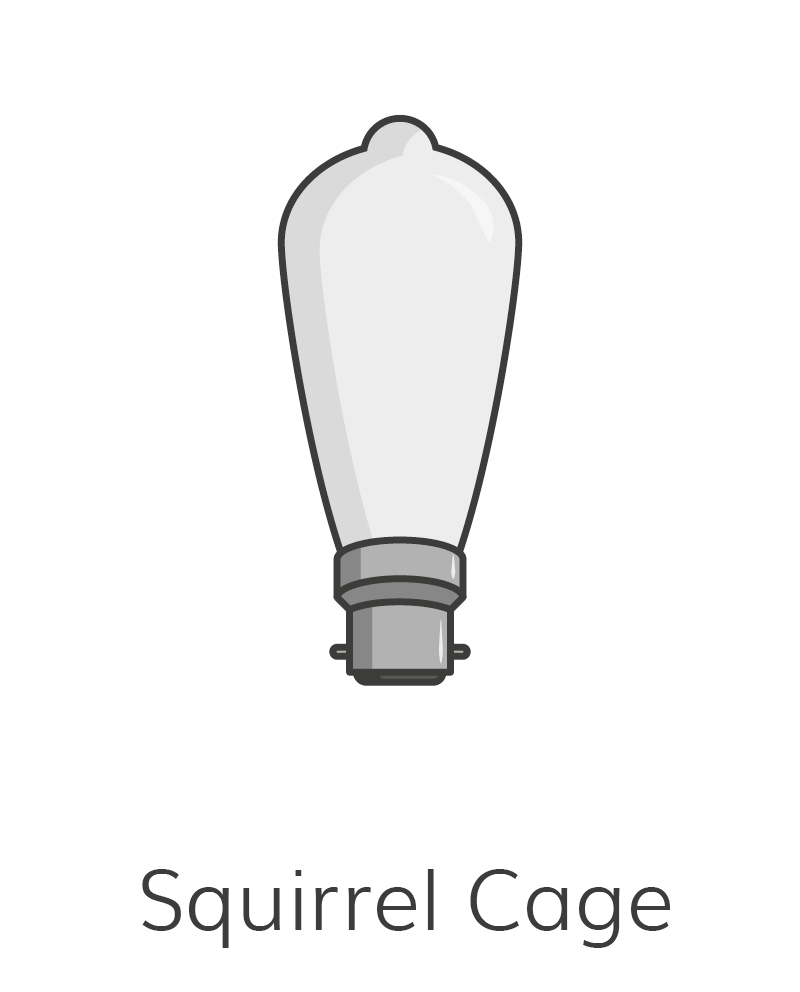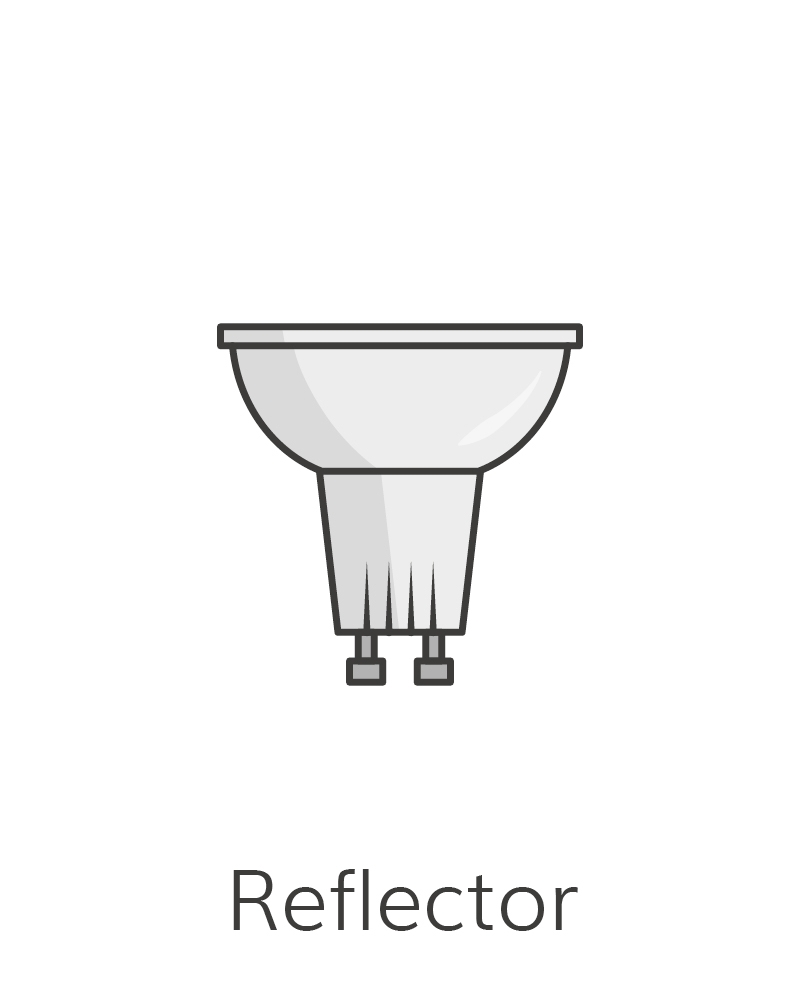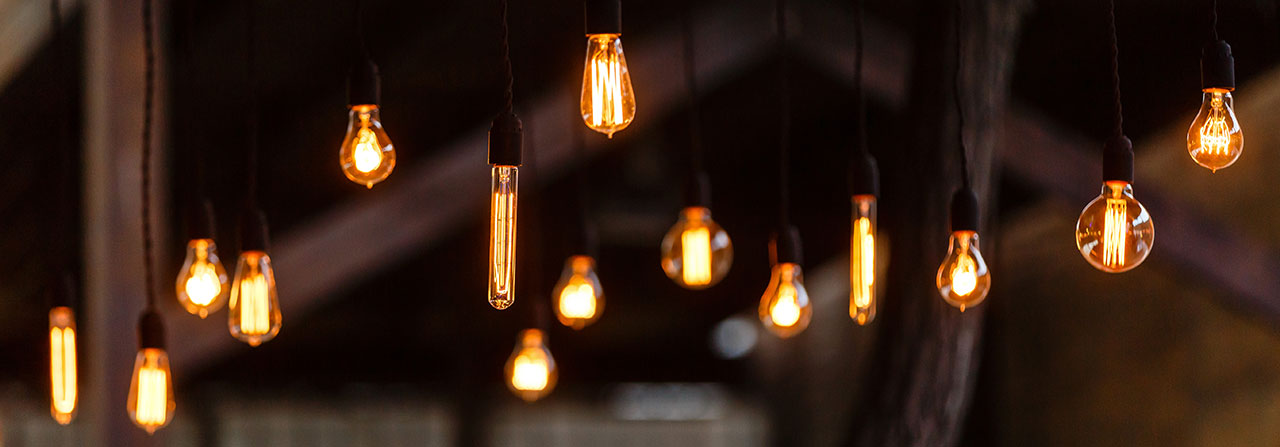
Learn all about LED bulbs and how to buy the right ones for your home
Energy efficient LED bulbs are now the new norm. They are no longer the expensive alternative option to the humble halogen or incandescent light bulb and offer so many great advantages. For a start, they’re much cheaper to run than traditional bulbs and can help save a whopping 90% on electricity costs once you make the switch. Think about how many bulbs you use around your home in each room. This alone can make a huge difference towards reducing overall carbon emissions. Then there’s the convenience of them as it can be many years between bulb changes, so it will be rare to have to replace them. They’re much safer, too, as they don’t produce heat and many can be recycled when no longer needed.
There is now a huge choice in LED bulb types, cap fittings, light colour and brightness, even a choice of devices from which to control your bulbs. Whilst this variety and choice certainly gives us lots of flexibility, it can also be overwhelming. Without the right information you could easily end up buying the wrong bulb.
In this guide, we’ll walk you through everything you need to know when it comes to choosing LED bulbs for just about everywhere around your home and beyond (click below to jump straight to that section):
What is LED?
LED Bulb Cap Fittings
- Bayonet cap
- Edison screw cap
- Spotlight cap (GU10)
- Capsule
- Small bayonet cap
- Small screw cap
- Spotlight cap
- Tube bulbs
Bulb Shapes
Brightness
Colour Temperature
Beam Angles
Smart Bulbs
Are LEDs Dimmable?
What is LED?
LED (light emitting diode) is a relatively new, electronic light source that is far superior in terms of energy efficiency and life span, when compared with older lighting such as halogen and incandescent. Whilst the very first LEDs were developed in the 1960s, it wasn’t until the 1990s that they became more widely used, yet were considered an expensive alternative to traditional bulbs. Since then, the price of LEDs has come down a lot, making them far more accessible. LED bulbs can last up to 50,000 hours, so in most cases it will be years before they have to be replaced. As they don’t produce any heat, they are much safer to use than older lightbulbs. Many can be recycled at the end of their long life span as they don’t contain mercury or lead components.
How much do LEDs cost to run?
One of the biggest advantages of using LEDs is that they can shave money off energy costs very easily. They only use a tiny fraction of the energy of a similar older style bulb so can help save around 90% on electricity bills after regular use. These savings soon add up when you consider the lighting used in a whole house, outdoors, in the garage or even an office.
How long do LEDs last?
LEDs do have huge life spans with some bulbs managing to last up to 50,000 hours. This is thanks to an efficient thermal management system inside the bulb meaning it removes any heat, which helps to preserve the life of the bulb. As incandescent and halogen bulbs became hotter the more they were used, they quickly burnt out and needed to be replaced often.
As LED bulbs are now available with a wide range of different caps, it’s important to know which cap fitting you need, so that you can choose the right one for your light fitting. Below is a guide to the eight most common caps that are available, to help you work out exactly what you need.
LED Bulb Cap Fittings
As LED bulbs are now available with a wide range of different caps, it’s important to know which cap fitting you need, so that you can choose the right one for your light fitting. Below is a guide to the eight most common caps that are available, to help you work out exactly what you need.
Bayonet cap
The classic bayonet cap is easily the most recognisable of all bulb caps. It features two signature pins either side of the metal base and can be pushed then twisted into place easily. 22mm in diameter, bayonet caps will fit into most everyday light fittings. The cap design makes them stay in place without any threads which prevents them from falling out if knocked.
Uses: Floor lamps, ceiling lights, multi-use all around the home.
Edison Screw Cap
The Edison screw cap is a versatile cap for all around the home, found on a huge variety of light bulbs. The metal spiral shape means it is twisted easily into place. 27mm in diameter, Edison screw caps will fit into most everyday light fittings.
Uses: Floor lamps, ceiling lights, various uses around the home.
Spotlight Cap (GU10)
The GU10 spotlight cap is one of two classic fittings found on a spotlight bulb. The small cap features two pins with flat feet on the end so they can be pushed and twisted into place easily. This common cap fitting can be found on a wide range of LED spotlight bulbs, many of which provide an exact replacement for halogen spotlights.
Uses: Kitchen unit lighting, downlighting, track lighting, recessed lighting.
Capsule
Capsule caps are usually found on a small compact bulb that is used in specialist equipment such as projectors, decorative lights or in certain kitchen appliances. It features two small pins at the bottom allowing it to be easily slotted in the fitting.
Uses: Small fittings and kitchen appliances, display cabinets, covered lights.
Small Bayonet Cap
A small bayonet cap is a common fitting found in many different small LED bulbs, suitable for all around the home especially in more compact light fittings. Using the simple push and twist mechanism, the 15mm diameter cap is held in place firmly once fitted properly.
Uses: Ceiling lights, desk lamps, smart lamps.
Small Screw Cap
The small Edison screw cap can be found in many types of smaller LED bulbs such as candles and golf balls styles, often used in compact light fittings. The diameter measures 14mm cross the cap and it is easy to fit with a simple screw in motion.
Uses: Table lamps, smaller decorative lights, chandeliers.
Spotlight Cap (MR16/MR11)
The MR16 spotlight cap features two straight metal pins at the base of the cap which will slot into the fitting readily. This cap is found on a wide range of low voltage classic spotlight LED lightbulbs, suitable for use in kitchens and recessed lighting all around the home.
Uses: kitchen unit lighting, downlighting, track lighting.
Tube Bulbs
LED tube caps feature a two pin fitting, with caps located at each end of the LED tube and 5mm between each of the pins. This type of cap is commonly found on smaller LED tubes used under kitchen cabinets as well as in workshops and replaces fluorescent tube lighting.
Uses: Garages, workshops, kitchens (under cabinets), display cabinet lighting, aquariums.

Bulb Shapes
The choice of bulbs shapes and styles now available is larger than ever before. Many bulbs have now been specially designed in a decorative finish, so they can be seen once in their fitting. The sheer choice can be confusing, especially if you don’t know which shape bulb should go in which light fitting. To help you make the right decision, here’s a rundown of six popular light bulb shapes.
GLS/ Traditional
GLS or traditional is the most recognisable and popular shaped bulb on the planet, sure to be found in homes everywhere. Fitted with either a classic bayonet or screw cap, they are suitable for ceiling light fittings, pendants, floor lamps and lots more. The choice of colour temperatures, dimmable or non-dimmable, lumens and smart features is huge with this type of bulb, so they are very versatile.
Uses: Ceiling lights, pendants, floor lamps, table lamps.
Globe
The globe shaped bulb is a stylish modern take on an older style of bulb, available in a range of colour temperatures, lumens, and finishes. Many decorative LED globe bulbs feature a visible filament so they complement larger exposed light fittings. They are usually fitted with a bayonet or screw cap.
Uses: Large pendants, ceiling lights, floor lamps.
Candle
Designed in the exact shape of a candle flame, these decorative candle bulbs are made to be see and often used in fixtures such as grand chandeliers and ceiling lights with multiple arms. With either a screw or bayonet cap, they are very easy to fit and are widely available in a variety of colour temperatures, finishes and lumens.
Uses: Small table/bedside lamps, chandeliers, ceiling lights.
Golfball
These small rounded bulbs are ideal for space-saving light fittings, such as small pendants, ceiling lights and lamps. Golfball bulbs usually come with a bayonet or screw cap and are a great bulb for a wide variety of light fittings all around the home.
Uses: Small ceiling lights, table/desk lamps.
Squirrel Cage
These stylish teardrop or pear-shaped LED bulbs are decorative and designed to be used in fittings that will display them, such as glass or wire caged pendants. Many Squirrel Cage bulbs also feature visible filaments as part of the design. They come with either a bayonet or screw cap fitting and dimmable options are available.
Uses: Ceiling lights, wall lights, desk lamps.
Reflector (GU10/MR16)
This shaped bulb is so named as the inside has a reflective finish, creating a wide beam of light. LED reflectors have replaced old style halogen reflectors, but use a tiny fraction of the energy for the same output. They sit recessed into the ceiling and have a bayonet or screw cap.
Uses: Spotlights in kitchens, hallways, security lighting.
Brightness
When we think about the brightness of light bulbs we are used to thinking about watts or wattage. Watts refer to the amount of energy a bulb uses – so the higher the wattage, the more power the bulb would be using. However, now that LED bulbs use hardly any energy at all, we use lumens (lm) instead of watts, as an indication of brightness.

The lumen output tells you the brightness of a bulb. In simple terms, lumens are a measure of the total amount of visible light to the human eye from a light source. The higher the lumen rating, the brighter your light will appear. The number of lumens you’ll need will entirely depend on the type of bulb you’re buying, the fixture it’s being used for, and the size and shape of the room where it will be placed. There is no right answer for this, as only you can decide how bright you want your bulbs
When you are next shopping for lightbulbs, look at the packaging as you will notice that the lumens may be listed alongside what their equivalent in watts would have been, to give you an indication of power.
Colour Temperature
Colour temperature is important to consider when deciding on which bulb should go where in your home. Generally, warmer light with yellow tones, is suited to creating a calm and relaxed atmosphere. Cooler lighting with bluer tones, is best for areas where you need to feel alert, energised and on the ball.
The colour temperature of a bulb is measured in Kelvins. The Kelvin Scale runs in the opposite direction to the temperature scale so the warmer the glow colour, the lower the number of Kelvins.

Warm White

Cool White

Daylight
When replacing a bulb do remember to take note of the Kelvins as well as the brightness and the wattage. If you don’t, you could end up with mismatched bulbs next to each other on the ceiling or in a multi arm fixture. This won’t look right and you won’t be utilising your lighting to the best of its ability.
For example, if you want to choose bulbs for the living room or bedrooms, you’d go for warm white in ceiling lights and lamps. For an office space, garage or bathroom where lots of focussed tasks are happening, you might opt for cool white bulbs in desk lamps and spotlights. Daylight bulbs, which mimic sunlight and produce crisp, invigorating light, work best in garages or for security lighting. For these areas, rather than standard bulbs you might choose LED tubes or floodlights.
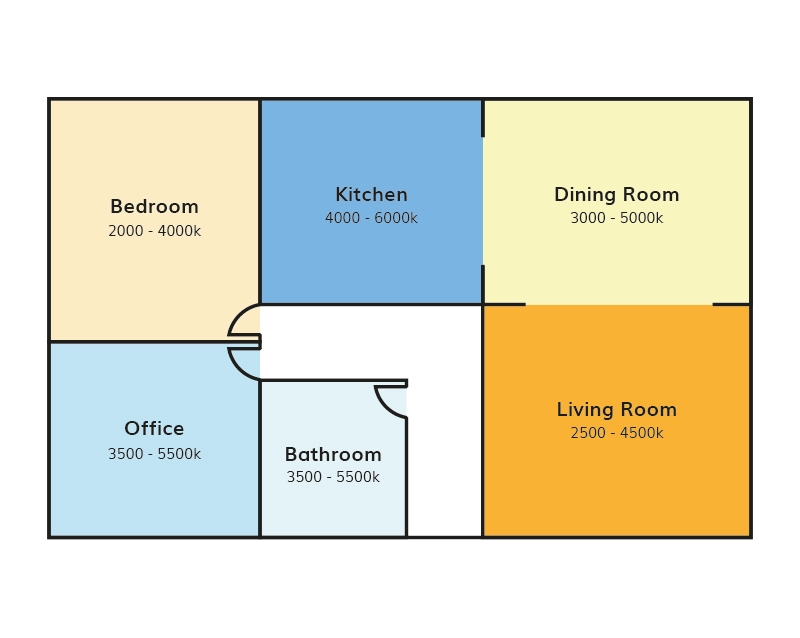
Beam Angles
The beam and direction of the light emitted from LED bulbs is almost as important as all the other factors. If you want to highlight a certain area or an object (maybe a framed print or certain corner of the room) then opt for low beam angled bulbs. These work especially well in smaller spaces when fitted closely together.
For larger more open rooms, it’s best to go with a bulb that has a wide beam angle. It will produce vast light that sprawls across a space.
It’s also worth noting that different materials can give different results when thinking about beam angles. For instance, a glass bulb will produce a higher beam angle than a plastic bulb.



Smart Bulbs
Smart bulbs will truly elevate your lighting to the next level. Choose from various colour options that can be operated via WIFI, Bluetooth even your voice activated devices. There are smart bulbs with speakers installed, motion sensors, and even bulbs to encourage houseplants to grow. There are so many exciting options to delve into.
The Phillips Hue white and colour changing LED bulbs come complete with the Hue Bridge and dimmer switch, ready to set up your connected lighting. Once installed it can be controlled via your mobile phone using an app and is compatible with Google Home, Amazon Echo and Apple Homekit devices.
A remote control for smart bulbs is a key piece of kit included in iDual’s pack of colour changing LED dimmable bulbs. Choose from the many colour, dimming, and of course on and off options, all accessible from the palm of your hand.
Some smart bulbs include the option to use your mobile phone’s Bluetooth to operate, such as the Smart + by Osram. Simply replace your existing bulbs with these, connect to your device and enjoy controlling your lighting using your own voice commands.
Take the fuss out of outdoor lighting by choosing LED bulbs with a built-in dusk to dawn sensor, such as this warm white LED decorative filament bulb by Lucide. Fit into your outdoor wall lights then sit back and relax as it automatically switches on, as the sun goes down and produces ambient lighting.
Dimmables
Having the option to dim the lights is perfect if you want flexibility from your living spaces. Afterall you might need bright lighting for working from home, but much softer lighting for dinner in the kitchen/dining room. However, not all LED bulbs can be used with dimmers, so do plan ahead if this is something you might require in the future. Look out for a special symbol on the light bulb’s packaging which will indicate whether it is dimmable or not.
Whilst some older style dimmer switches will work with dimmable LED bulbs, some will not and they can cause issues. They can make the lights flicker or create a buzzing sound. If this does happen you will need to ensure you use an LED bulb and compatible dimmer switch designed for use with LED. If you do choose dimmable LEDs, the good news is you don’t need a dimmer switch for them to work.
At Online Lighting we have a great selection of LED bulbs to suit your needs. Whether you want to transform your living spaces with cutting edge technology or create cosy lighting in the baby’s nursery, we are sure to have just the solution for you. If you have any questions about products or need some expert advice, why not email our friendly customer service team at customerservice@onlinelighting.co.uk.
Reena Reeves
Reena Reeves is a writer and editor with 15 years’ experiencing working in publishing and digital media. She has a degree in Journalism and has worked for publications such as Smash Hits magazine, OK! Magazine and The Daily Express. Reena has been writing about lighting since early 2017 and has supported us with website copy, product descriptions and articles on lighting trends and commercial lighting solutions.

